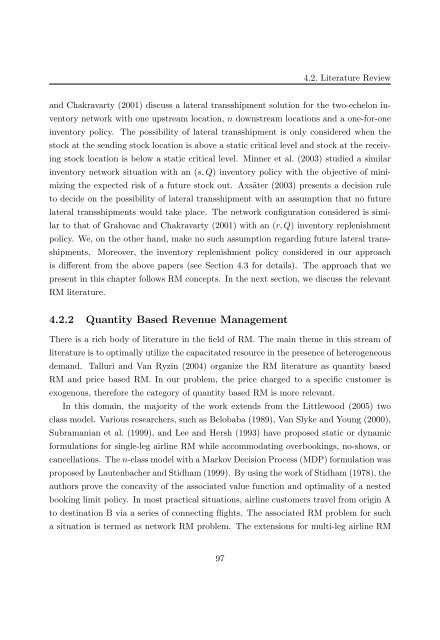Customer Information Driven After Sales Service ... - RePub
Customer Information Driven After Sales Service ... - RePub
Customer Information Driven After Sales Service ... - RePub
Create successful ePaper yourself
Turn your PDF publications into a flip-book with our unique Google optimized e-Paper software.
4.2. Literature Review<br />
and Chakravarty (2001) discuss a lateral transshipment solution for the two-echelon inventory<br />
network with one upstream location, n downstream locations and a one-for-one<br />
inventory policy. The possibility of lateral transshipment is only considered when the<br />
stock at the sending stock location is above a static critical level and stock at the receiving<br />
stock location is below a static critical level. Minner et al. (2003) studied a similar<br />
inventory network situation with an (s, Q) inventory policy with the objective of minimizing<br />
the expected risk of a future stock out. Axsäter (2003) presents a decision rule<br />
to decide on the possibility of lateral transshipment with an assumption that no future<br />
lateral transshipments would take place. The network configuration considered is similar<br />
to that of Grahovac and Chakravarty (2001) with an (r, Q) inventory replenishment<br />
policy. We, on the other hand, make no such assumption regarding future lateral transshipments.<br />
Moreover, the inventory replenishment policy considered in our approach<br />
is different from the above papers (see Section 4.3 for details). The approach that we<br />
present in this chapter follows RM concepts. In the next section, we discuss the relevant<br />
RM literature.<br />
4.2.2 Quantity Based Revenue Management<br />
There is a rich body of literature in the field of RM. The main theme in this stream of<br />
literature is to optimally utilize the capacitated resource in the presence of heterogeneous<br />
demand. Talluri and Van Ryzin (2004) organize the RM literature as quantity based<br />
RM and price based RM. In our problem, the price charged to a specific customer is<br />
exogenous, therefore the category of quantity based RM is more relevant.<br />
In this domain, the majority of the work extends from the Littlewood (2005) two<br />
class model. Various researchers, such as Belobaba (1989), Van Slyke and Young (2000),<br />
Subramanian et al. (1999), and Lee and Hersh (1993) have proposed static or dynamic<br />
formulations for single-leg airline RM while accommodating overbookings, no-shows, or<br />
cancellations. The n-class model with a Markov Decision Process (MDP) formulation was<br />
proposed by Lautenbacher and Stidham (1999). By using the work of Stidham (1978), the<br />
authors prove the concavity of the associated value function and optimality of a nested<br />
booking limit policy. In most practical situations, airline customers travel from origin A<br />
to destination B via a series of connecting flights. The associated RM problem for such<br />
a situation is termed as network RM problem. The extensions for multi-leg airline RM<br />
97

















